Woodhaven Nature Conservancy Regional Park
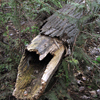
Alternate Guide
Written by Nancy Holmes
Designed by Shed Simas
This is a rough digital emulation of the printed guide. Click the thumbnails to load the images.
Trail Map
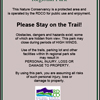
The trails in the park loop around inside a fence; they are not a journey. They are something else. A knot, maybe. The paths braid your feet into soil, directions, twigs, stories. Sometimes you have to cross a path you walked before. This is teaching you something.

Geography and time are entwined together. The Cottonwood Zone and its slow dying knit themselves into the Douglas Fir Zone and its needle sizzle, which stitch in and out of the long hem of the Ponderosa pine zone as it throws itself down the dry cliffside, in a tangle of butterfly and cactus, right into the multi-tangled arms of the western red cedar zone, brooding in its dark melancholy, weeping moisture into the air, pressing curly moss on the brow of the Cottonwood Zone. Look at geography and time twin, brail, and trellis another moment, another stone into place.
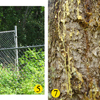
5. Chainlink Fence
Look at the fence in front of you. Your skin sieves hot and cold. Your skin is your chain link fence.
7. Sap-Bleeding Tree
Your body is the hinge between nature — see the sap-bleeding tree — and culture — see the sign nailed onto the tree's bark. Where are you leaking?
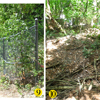
9. Border
You're at the edge of the Ponderosa Pine Zone, the Western Red Cedar Zone, and the Neighbours' Yards. Everything is a web, not a list. Everything is an antler, not a border.
10. Empty Creek Bed
Let's be organo- nano- bio- eco- geo- cogno- techno- ego- tango- quanto- philo- centric. Take metal shed and cedar fan. Take empty creekbed and cedars watering the air with their breath.
Birds you may see at Woodhaven
brown birds twittering in branches
I've been hit by a hummingbird
swallows stringing holes and mosquitoes together
birds singing invisibly
I dreamt of a bird last night
a feather on the forest floor
magpies strutting in muscle shirts
I never see birds
birds remind me of reptiles and scare me
birds wake me up at 4 AM
drawing of a Western Screech Owl in the Parking Lot
a robin
The Past
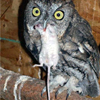
When we are children, we are immersed in sensation. We feel every moment of our long, thing-filled days and everything that happens to us and that we eat, touch, or see is astonishing. But when we get to ten, or eleven, or twelve years old (when did it happen to you?) consciousness erupts in our bodies, its huge bloom swelling in our heads. The self begins its great blotting, prickling invasion, so intense, so mushrooming, many cannot bear it so try to crush it, smother it, kill it, push it down with drugs, or drink, or fantasies, or reading, or video games, or manias, or busy little gangs of thugs or friends, anything to distract us from the rampant, exploding awareness of the empty inner self and its terrible hunger for meanings. No one teaches us how to live with this new thing in us. No one helps us know what it is.
The Present
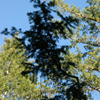
We advise you to come to the woods. Sit down and look at a large tree moving in a breeze. Each tree is a mirror of one of your thoughts. The tens of thousands of leaves and needles twist and flip, the branches stir and bend, the roots and filaments crack through dirt and rock beneath you in the dark. Each leaf, each filament rubs and strokes the nerve that's burning in your brain. All around you are your other thoughts. Each thought, like each tree, is being cooled and rubbed and thumbed open. You can learn the ecology of your brain here. You can air out each thin thought, each sticky obsession. As Rilke says, so often we don't notice or even care that we are alive. Let us be struck with the beauty and terror of our lives and thus feel peace.
Please Protect This Area
Be uncertain in the woods. What do you really know?
Ignore the asphalt sermons you hear every day.
Cain in the moon. Coyote in the moon. You choose.
Nature does not repent making bears or cougars.
Be polite in the woods. It's not a mountain or a lake.
All around you is the massive implementation of tiny roots and cells.
Remember: Nature has also imagined You.

Please use this brochure to enjoy your visit to Woodhaven. You may keep it, or return it to the dispenser for others to read.
Contact Us!
The Woodhaven Eco Art Project
http://www.woodhaven.ok.ubc.ca/
This project is funded by The Hampton Fund at the University of British Columbia.
